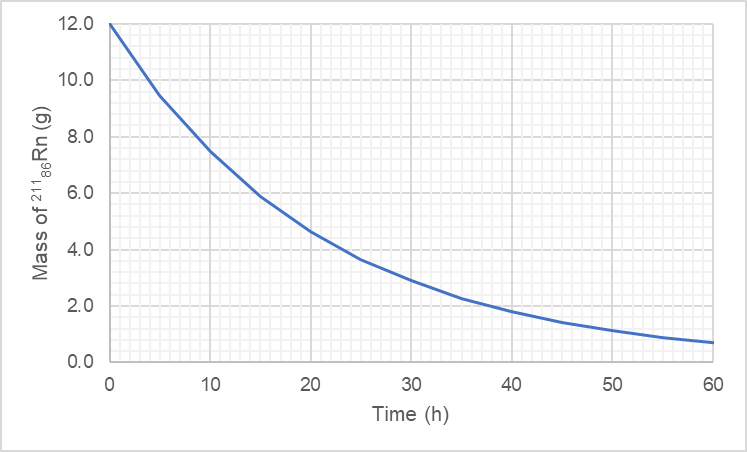 Back
BackProblem 1a
Indicate whether each of the following nuclides lies within the belt of stability in Figure 21.2: (a) neon-24. For any that do not, describe a nuclear decay process that would alter the neutron-to-proton ratio in the direction of increased stability. [Section 21.2]

Problem 2
Write the balanced nuclear equation for the reaction represented by the diagram shown here. [Section 21.2]

- Complete and balance the following nuclear equations by supplying the missing particle: (b) 40₁₉K + 0₋₁e → ? (c) ? + 4₂He → 30₁₄Si + 1₁H
Problem 3
Problem 4c
In the sketch below, the red spheres represent protons and the gray spheres represent neutrons. (c) Based on its atomic number and mass number, do you think the product nucleus is stable or radioactive? [Section 21.3]

Problem 5a
The steps below show three of the steps in the radioactive decay chain for 23290Th. The half-life of each isotope is shown below the symbol of the isotope. (a) Identify the type of radioactive decay for each of the steps (i), (ii), and (iii). [Sections 21.2 and 21.4]

Problem 5d
The steps below show three of the steps in the radioactive decay chain for 23290Th. The half-life of each isotope is shown below the symbol of the isotope. (d) The next step in the decay chain is an alpha emission. What is the next isotope in the chain? [Sections 21.2 and 21.4]
- (a) What is the function of the moderator in a nuclear reactor? (b) What substance acts as the moderator in a pressurized water generator?
Problem 6
Problem 6a
The accompanying graph illustrates the decay of 8842Mo, which decays via positron emission. (a) What is the halflife of the decay? [Section 21.4]

Problem 6b
The accompanying graph illustrates the decay of 8842Mo, which decays via positron emission. (b) What is the rate constant for the decay? [Section 21.4]
Problem 6c
The accompanying graph illustrates the decay of 8842Mo, which decays via positron emission. (c) What fraction of the original sample of 8842Mo remains after 12 min? [Section 21.4]

Problem 6d
The accompanying graph illustrates the decay of 8842Mo, which decays via positron emission. (d) What is the product of the decay process? [Section 21.4]

- A 65-kg person is accidentally exposed for 240 s to a 15-mCi source of beta radiation coming from a sample of 90Sr. (a) What is the activity of the radiation source in disintegrations per second? In becquerels? (b) Each beta particle has an energy of 8.75 * 10^-14 J, and 7.5% of the radiation is absorbed by the person. Assuming that the absorbed radiation is spread over the person’s entire body, calculate the absorbed dose in rads and in grays. (c) If the RBE of the beta particles is 1.0, what is the effective dose in mrem and in sieverts? (d) Is the radiation dose equal to, greater than, or less than that for a typical mammogram (300 mrem)?
Problem 7
Problem 7b
All the stable isotopes of boron, carbon, nitrogen, oxygen, and fluorine are shown in the accompanying chart (in red), along with their radioactive isotopes with t1>2 7 1 min (in blue). (b) Which radioactive isotopes are most likely to decay by beta emission? [Sections 21.2, 21.4, and 21.5]

- A sample of an alpha emitter having an activity of 0.18 Ci is stored in a 25.0-mL sealed container at 22 _x001D_C for 245 days. (b) Assuming that each alpha particle is converted to a helium atom, what is the partial pressure of helium gas in the container after this 245-day period?
Problem 9
Problem 9b
Indicate the number of protons and neutrons in the following nuclei: (b) 193Tl.
Problem 10c
Indicate the number of protons and neutrons in the following nuclei: (c) neptunium-237.
- What is the symbol for (a) a neutron?
Problem 11
Problem 11b
Give the symbol for (b) an alpha particle.
Problem 11c
Give the symbol for (c) gamma radiation.
- What is the symbol for (a) a proton?
Problem 12
Problem 12b
Give the symbol for (b) a beta particle.
Problem 12c
Give the symbol for (c) a positron.
Problem 13a
Write balanced nuclear equations for the following processes: (a) rubidium-90 undergoes beta emission.
Problem 13b
Write balanced nuclear equations for the following processes: (b) selenium-72 undergoes electron capture.
Problem 13c
Write balanced nuclear equations for the following processes: (c) krypton-76 undergoes positron emission.
Problem 13d
Write balanced nuclear equations for the following processes: (d) radium-226 emits alpha radiation.
Problem 14a
Write balanced nuclear equations for the following transformations: (a) bismuth-213 undergoes alpha decay.
Problem 14b
Write balanced nuclear equations for the following transformations:
(b) nitrogen-13 undergoes electron capture.
Problem 14c
Write balanced nuclear equations for the following transformations: (c) technicium-98 undergoes electron capture.
Problem 14d
Write balanced nuclear equations for the following transformations: (d) gold-188 decays by positron emission.
